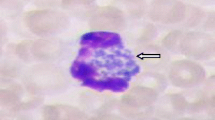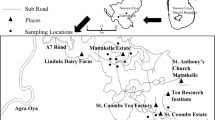Abstract
Early diagnosis of Ehrlichia ruminantium in cattle is a recipe for effective control of heartwater in ruminants. Hence, we assessed the presence of E. ruminantium in the blood of cattle and the engorged Amblyomma variegatum by nested PCR. The electrophoresed PCR products obtained after primary and secondary amplifications revealed amplicon sizes of about350 bp and 280 bp respectively, which corresponded with the partial region of pSC20 gene amplified. Sequences obtained had 95–99% homology with those sequences available in GenBank. The prevalence of the E. ruminantium in ticks (50%; 126/252) was significantly (p < 0.05) higher than that in cattle blood 23.55% (61/259). The prevalence was significantly (p < 0.05) higher in ticks from adult cattle 51.47% (133/259) than those from the young cattle 44.86% (116/259) and in tick from females 54.55% (141/259) than in ticks from the males 41.38% (107/259). Alignment of autochthonous sequences revealed that the three sequences were polymorphic with two sequences showing similar nucleotides deletion at points 87–91 and 107–108. The phylogenetic trees inferred by ML showed topologies with two autochthonous sequences, one each from cattle blood and tick, clustering together in one clade and the other clustering within those sequences from South Africa and Zimbabwe in another clade. In conclusion, this study revealed a higher prevalence of E. ruminantium in engorged A. variegatum than in the blood of infected cattle. Hence, it is suggested that the amplification that targets the pCS20 gene in engorged ticks may be more suitable to determine the E. ruminantium carrier status of cattle.


Similar content being viewed by others
References
Adakal H, Stachurski F, Konkobo M, Zoungrana S, Meyer DF, Pinarello V, Aprelon R, Marcelino I, Alves PM, Martinez D, Lefrancois T, Vachiéry N (2010) Efficiency of inactivated vaccines against heartwater in Burkina Faso: impact of Ehrlichia ruminantium genetic diversity. Vaccine 28(29):4573–4580
Ahamefule FO, Ibeawuche JA, Okereke SN, Anyanwu AC (2007) Reproductive performance of White Fulani, N’dama and their crossbred in a hot humid environment. J Anim Vet Adv 6(8):955–958
Allsopp BA (2010) Natural history of Ehrlichia ruminantium. Vet Parastiol 167:123–135
Allsopp MTEP, Allsopp BA (2007) Extensive genetic recombination occurs in the field between genotypes of Ehrlichia ruminantium. Vet Microbiol 124(1–2):58–65
Allsopp MTEP, Van Strijp MF, Faber E, Josemans AI, Allsopp BA (2007) Ehrlichia ruminantium variants which do not cause heartwater found in South Africa. Vet Microbiol 120(1–2):158–166
Awa DN (1997) Seroligical survey of heartwater relative to the distribution of the vector Amblyomma variegatum and other ticks species in north Cameroun. Vet Parasitol 68(1–2):165–173
Bell-Sakyi L, Koney EB, Dogbey O, Sumption KJ (1996) Heartwater in Ghana: implications for control ticks. Trop Anim Health Prod 28:59–64
Biguezoton A, Noel V, Adehan S, Adakal H, Dayo G, Zoungrana S, Farougou S, Chevillon C (2016) Ehrlichia ruminantium infects Rhipicephalus microplus in West Africa. Parasit Vector 9:354
Chitanga S, Gaff H, Mukaratirwa S (2014) Tick-borne pathogens of potential zoonotic importance in the southern African region’. J S Afr Vet Assoc 85(1):1–3. https://doi.org/10.4102/jsava.v85i1.1084
Deem SL, Noval RAI, Yonow T, Peter TF, Mahan SM, Burridge MJ (1996) The epidemiology of heartwater: establishment and maintenance of endemic stability. Trend Parasitol 12(10):402–405
Esemu SN, Ndip LM, Ndip RN (2011) Ehrlichia Species, Probable Emerging Human Pathogens in Sub-Saharan Africa: environmental Exacerbation. Rev Environ Health 26(4):269–279
Esemu SN, Besong WO, Ndip R, Ndip L (2012) Prevalence of Ehrlichia ruminantium in adult Amblyomma variegatum collected from cattle in Cameroun. Exp Appl Acarol 59(3):377–387
Faburay B, Geysen D, Munstermann S, Faoufik A, Postigo M, Jongejan F (2007) Molecular detection of Ehrlichia ruminantium infection in Amblyomma variegatum ticks in The Gambia. Exp Appl Acarol 42(1):61–74
Hart A, Kocan KM, Bezuidenhou JD, Prozeskyc L (1991) Ultrastructural morphology of Cowdria ruminantium in midgut Epithelial cells of adult Amblyomma hebraeum female ticks. Onderstepoort J Vet Res 58:187–193
Heerden HV, Steyn HC, Allsopp MTEP, Allsopp BA (2004) Characterization of pCS20 region of different of Ehrlichia ruminantium isolates. Vet Microbiol 101(4):279–291
Kasari TR, Miller RS, James AM, Freier JE (2010) Recognition of the threat of Ehrlichia ruminantum infection in domestic and wild ruminants in the continental United State. J Am Vet Med Assoc 237(5):520–530
Knopf L, Komoin-Oka C, Betschart B, Jongejan F, Gottstein B, Zinsstag J (2002) Seasonal epidemiology of ticks and aspect of cowdriosis in N’dama Village cattle in the Central Guinean savannah of Cote D’lvoirs. Prevent Vet Med 53(1–2):21–30
Leeflang P, Ilemobade AA (1977) Tick-borne diseases of domestic animals in northern Nigeria. Trop Anim Health Prod 9(4):211–218
Lorusso V, Wijnveld M, Majekodunmi AO, Dongkum C, Fajinmi A, Dogo AG, Thrusfield M, Mugenyi A, Vaumourin E, Igweh AC, Jongejan F, Welburn SC, Picozzi K (2016) Tick-borne pathogens of zoonotic and veterinary importance in Nigerian cattle. Parasit Vector 9:217
Louw M, Allsopp MTEP, Meyer EC (2006) Ehrlichia ruminantium, an emerging human pathogen—a further report. S Afr Med J 95(12):948–950
Mahan SM, Waghela SD, McGuire TC, Rurangirwa FR, Wassink LA, Barbet AF (1992) A cloned DNA probe for Cowdria ruminantium hybridizes with eight heartwater strains and detects infected sheep. J Clin Microbiol 30:981–986
Mahan SM, Simbi BH, Burridge MJ (2004) The pCS20 PCR assay for Ehrlichia ruminantium does not cross-react with the novel deer ehrlichial agent found in white-tailed deer in the United States of America. Onderstepoort J Vet Res 71:99–105
Martinez D, Vachiery N, Starchursky F, Kandassamy Y, Raliniaina M, Aprelon R, Gueye A (2004) Nested PCR for detection and genotyping of Ehrlichia ruminantium: use in genetic diversity analysis. Ann N Y Acad Sci 1026:106–113
Molia S, Frebling M, Vachiery N, Pinareno V, Petitclerc M, Rousteau A, Martinez D, Lefrancois T (2008) Amblyomma variegatum in cattle in Marie Galante, French Antilles; prevalence, control measure and infection by Ehrlichia ruminantium. Vet Parasitol 153(3–4):338–346
Ogo N, Fernandez de Mera II, Scimeca RC, Okubanjo OO, Inuwa HM, Agbede RIS, Torina A, Alongi A, Vicente J, Gortazar C, Dela Fuente J (2012) Molecular identification of ticks borne pathogen in Nigerian ticks. Vet Parasitol 187(3–4):572–577
Okello-Onen J, Hassan SM, Essuman S (2006) Taxonomy of African ticks. ICIPE Science Press, Nairobi
Otchere EO (1983) The productivity of Bunaji (White Fulani) cattle in pastoralist herds on the Kaduna plains of Nigeria. International Livestock Centre for Africa (ILCA) Sub-humid Programme Kaduna. Internal Comm. No. 46. pp27
Peter TF, Barbet AF, Alleman AR, Simbi BH, Burridge MJ, Mahan SM (2000) Detection of the agent of heartwater, Cowdria ruminantium, in Amblyomma Ticks by PCR: validation and application of the assay to field ticks. J Clin Microbiol 38(4):1539–1544
Reye AL, Arinola OG, Hübschen JM, Mullera CP (2012) Pathogen prevalence in ticks collected from the vegetation and livestock in Nigeria. Appl Environ Microbiol 78(8):2562–2568
RIM (Resource Inventory and Management) (1993) Nigerian Livestock Reserves RIM report: Vol. I-IV. Federal Livestock Department and Pest Control Services, Federal Ministry of Agriculture, Abuja
Sayler KA, Loftis AD, Mahan SM, Barbet AF (2016) Development of a quantitative PCR Assay for differentiating the agent of heartwater disease, Ehrlichia ruminantium, from Panola Montain Ehrlichia. Transbound Emerg Dis 63(6):e260–e269
Steyn HC, Van Heerden H, Allsopp MTEP, Allsopp BA (2003) Variability of pCS20 gene sequences among different Ehrlichia ruminantium isolates. Ann N Y Acad Sci 990:723–725
Steyn HC, Pretorius A, McCrindle CME, Steinmann CML, Van Kleef M (2008) A quantitative real-time PCR assay for Ehrlichia ruminantium using pCS20. Vet Microbiol 131(3–4):258–265
Synge BA (1980) Factors limiting cattle productivity in highland areas of Nigeria II. Centre for Tropical Veterinary Medicine, Easter Bush, Roslin, Midlothian, Scotland, p 50
Takeet MI, Fagbemi BO, De Donatos M, Yakubu A, Rodulfo HE, Peters SO, Wheto M, Imumorin GI (2013) Molecular survey of pathogenic trypanosomes in naturally infected Nigerian cattle. Res Vet Sci 94(3):555–561
Thrusfield M (1995) Sampling. In: Veterinary epidemiology, 2nd edn. Black Well, London, pp 179–284
Van de Pypekamp HE, Prozesky L (1987) Heartwater: an overview of the clinical signs, susceptibility and differential diagnoses of the disease in domestic ruminants. Onderstepoort J Vet Res 54(3):263–266
Yunker CE (1996) Heartwater in sheep and Goats: a review. Onderstepoort J Vet Res 63:159–170
Acknowledgements
We thank Mr Olugbogi, E. I. of the Department of Veterinary Microbiology and Parasitology for technical support rendered during the course of this study.
Author information
Authors and Affiliations
Corresponding author
Ethics declarations
Ethical consideration
Ethical approval, Number FUNAAB/COLVET/CREC/001/18 was obtained from the College of Veterinary Medicine Ethical Committee, College of Veterinary Medicine, Federal University of Agriculture Abeokuta, Nigeria, before commencing the project.
Conflict of interest
The authors declare that they have no conflict of interest.
Additional information
Publisher's Note
Springer Nature remains neutral with regard to jurisdictional claims in published maps and institutional affiliations.
Rights and permissions
About this article
Cite this article
Anifowose, O.I., Takeet, M.I., Talabi, A.O. et al. Molecular detection of Ehrlichia ruminantium in engorged ablyomma variegatum and cattle in Ogun State, Nigeria. J Parasit Dis 44, 403–410 (2020). https://doi.org/10.1007/s12639-020-01218-4
Received:
Accepted:
Published:
Issue Date:
DOI: https://doi.org/10.1007/s12639-020-01218-4




